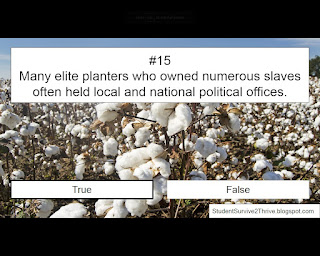 |
| Photo of cotton field by jdblack at https://pixabay.com/photos/cotton-cotton-field-white-farming-4649804/ |
U.S. History Week 12
Cotton is King: The Antebellum South, 1800-1860
I designed a quiz related to chapter 12 at the bottom of this article.
Directions for the quiz:
- Scroll down & click on the first thumbnail to enlarge to full screen.
- Choose an answer for each question.
- Click on the graphic to advance to the next screen.
- The correct answer is on the screen following the question.
- Compare your answers with those provided.
- If you cannot easily see the correct answer, check the captions.
An interactive version is available on Kahoot!
Search for this week’s topic by Katrena to find it.
Review the following Chapter 12 pages:
- Introduction
- The Economics of Cotton
- African Americans in the Antebellum United States
- Wealth and Culture in the South
- The Filibuster and the Quest for New Slave States
- Key Terms
- Summary
Practice learning Chapter 12 Key Terms on Quizlet.
Week 12 Videos:
- Crash Course: The Rise of Cotton (12:10)
- The Louisiana Rebellion of 1811 (12:06)
- The Impact of Nat Turner’s Rebellion Still Felt Today (4:04)
- The True Story Behind “Uncle Tom’s Cabin” (7:23)
- The Ostend Manifesto (5:05)
- The American Who Proclaimed Himself President of a Latin American Country (6:35)
Review the following information featuring the U.S.:
Additional Resources:
Thanks for visiting my Student Survive 2 Thrive blog!
Find additional resources through my site map, topics tabs, or search bar.
Here are some of my articles you may find helpful this week:
 |
| U.S. History Week 12 Cotton is King: The Antebellum South 1800-1860 |
 |
| Created by Katrena All rights reserved. |
 |
| The years after the War of 1812 and before the Civil War are known as the ___ Period. Answer choices include: Reconstruction, Antebellum, Progressive, Colonization |
 |
| The correct answer is Antebellum. |
 |
| What was the South’s major cash crop of the Antebellum Period? Answer choices include: sugar, tobacco, rice, cotton |
 |
| The correct answer is cotton. |
 |
| Who wrote Uncle Tom’s Cabin in 1852? Answer choices include: James Hammond, J.N. Wilson, Harriet Beecher Stowe, Eli Whitley |
 |
| The correct answer is Harriet Beecher Stowe. |
 |
| Located at the mouth of the Mississippi River, ___ became an important and diverse American city in the early 1800s. Answer choices include: Savannah, New York City, Houston, New Orleans |
 |
| The correct answer is New Orleans. |
 |
| The trading of enslaved people within the United States was called ___ slave trade. Answer choices include: central, domestic, Atlantic, international |
 |
| The correct answer is domestic. |
 |
| Approximately __% of enslaved persons in America labored in cotton fields during the Antebellum Period. Answer choices include: 75, 50, 25, 10 |
 |
| The correct answer is 50. |
 |
| Enslaved people found solace in ___. Answer choices include: Christian faith, storytelling, music, All of these |
 |
| The correct answer is all of these. |
 |
| Slaveholders would use ___ to prevent enslaved persons from disobeying their wishes. Answer choices include: threats of selling the person, physical abuse, punishment gear, any of these |
 |
| The correct answer is any of these. |
 |
| More free Black people lived in the South than in the North. Answer choices include: true, false |
 |
| The correct answer is true. |
 |
| Upper Southern states had harsher laws that divested free Black people of their rights than Deep Southern states. Answer choices include: true, false |
 |
| The correct answer is true. |
 |
| Whose rebellion in Virginia caused the state’s legislators to consider ending slavery? Answer choices include: Manuel Andry, William Ellison, Nat Turner, Charles Desiondes |
 |
| The correct answer is Nat Turner. |
 |
| When did Congress ban further importation of enslaved Africans? Answer choices include: 1808, 1828, 1848, 1868 |
 |
| The correct answer is 1808. |
 |
| Between 1820 & 1860 during the second middle passage, at least ____ enslaved people were sold in the domestic market. Answer choices include: 10,000; 50,000; 100,000; 1 million |
 |
| The correct answer is 1 million. |
 |
| The majority of White people in the South owned slaves. Answer choices include: true, false |
 |
| The correct answer is false. |
 |
| Many elite planters who owned numerous slaves often held local and national political offices. Answer choices include: true, false |
 |
| The correct answer is true. |
 |
| Small landowners were called ___ farmers, which were what Jefferson had envisioned for the American dream. Answer choices include: yeoman, plantation, tenant, mercantile |
 |
| The correct answer is yeoman. |
 |
| Vocal groups committed to ending slavery were called ___. Answer choices include: white supremacists, abolitionists, the gentry, expansionists |
 |
| The correct answer is abolitionists. |
 |
| The Ostend Manifesto promoted the idea of overthrowing ___ for security reasons. Answer choices include: Cuba, Mexico, Canada, Haiti |
 |
| The correct answer is Cuba. |
 |
| In 1855, William Walker led a group of mercenaries to gain control of ___ to re-institute slavery. Answer choices include: Brazil, Panama, England, Nicaragua |
 |
| The correct answer is Nicaragua. |
 |
| The correct answer is concurrent majority. |
 |
| Find more resources at StudentSurvive2Thrive.blogspot.com |

No comments:
Post a Comment
Thanks for reading my article and sending your comment! Please note that I do not place links to other web sites on this blog.
Note: Only a member of this blog may post a comment.